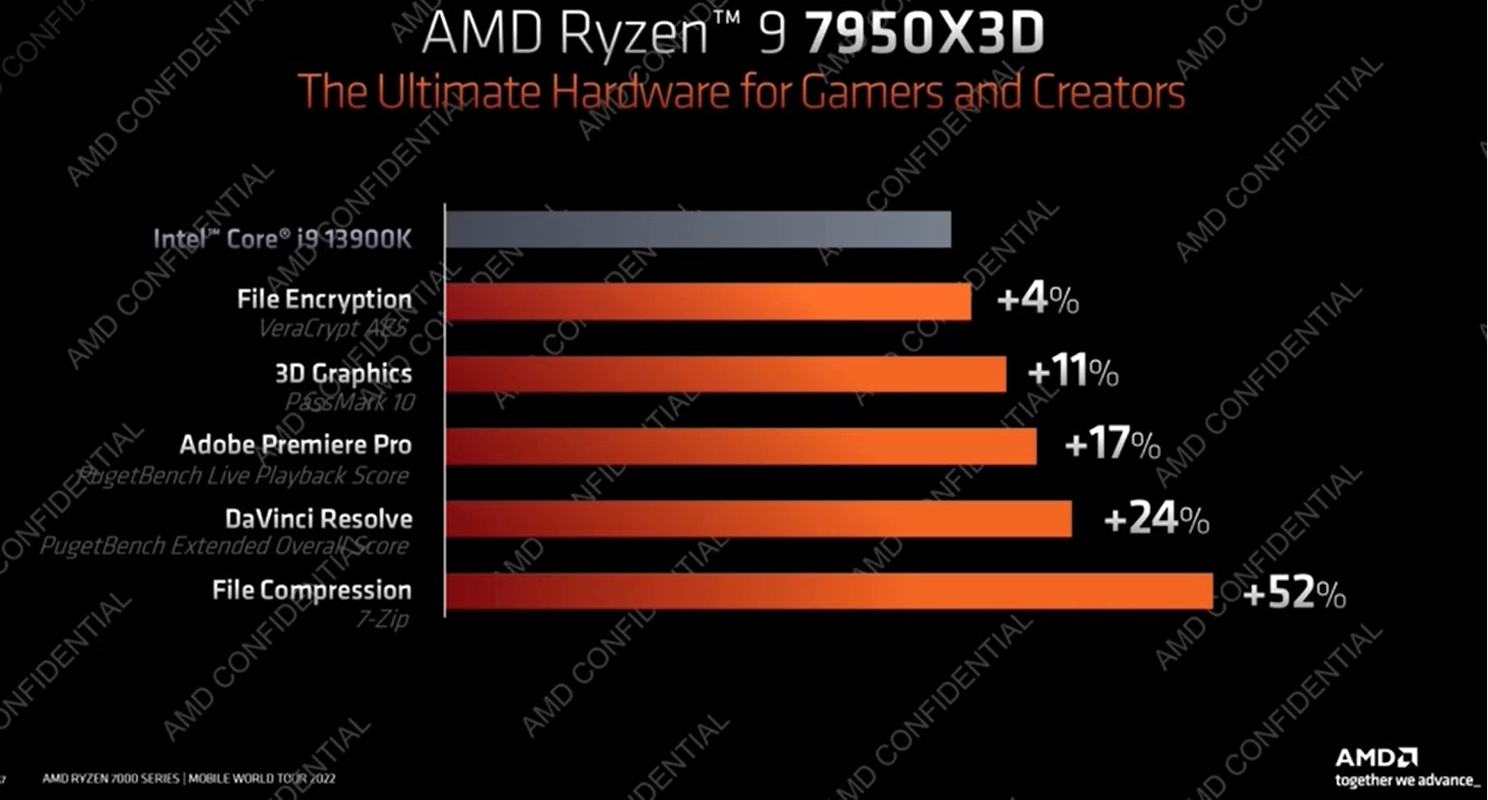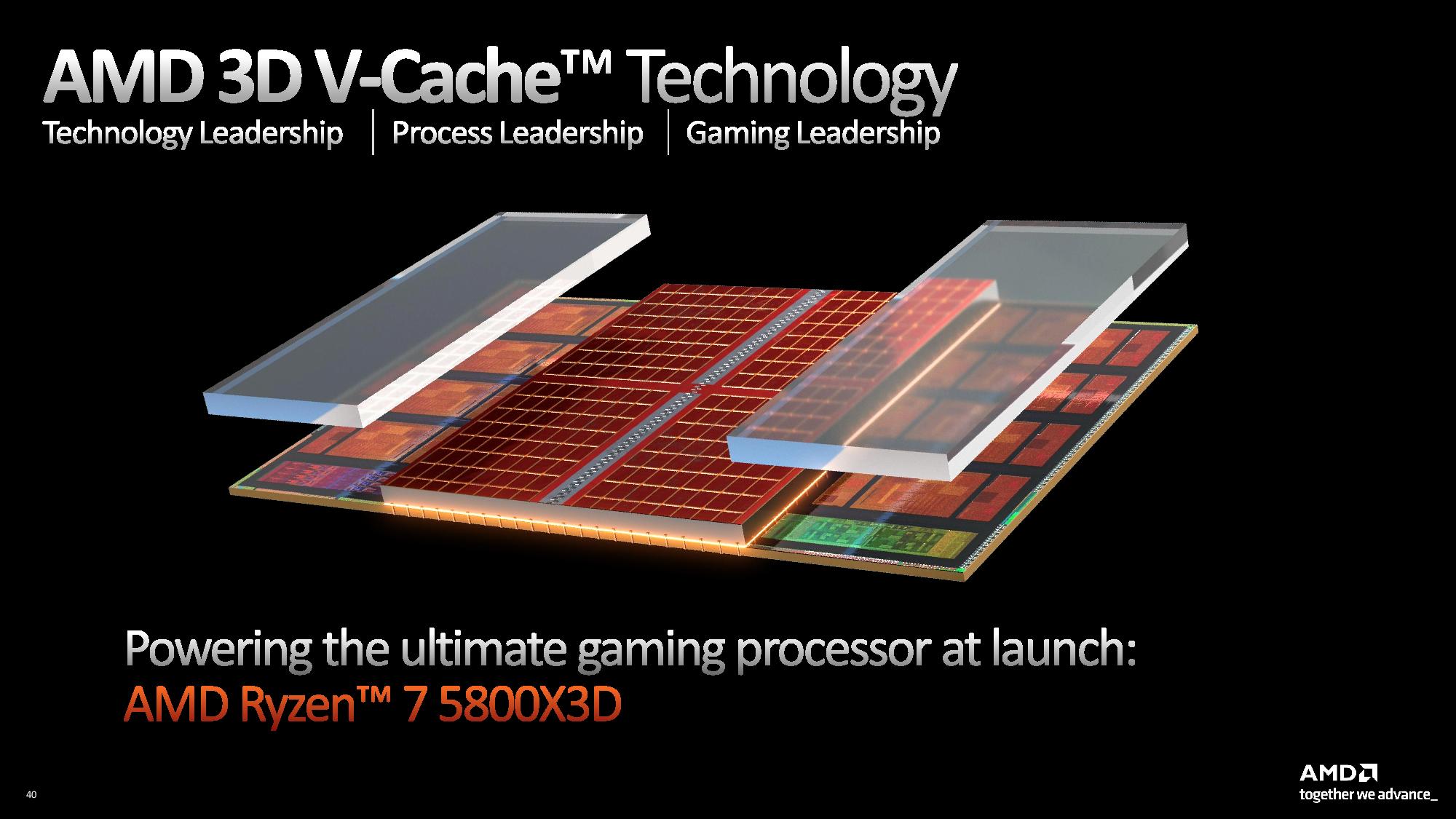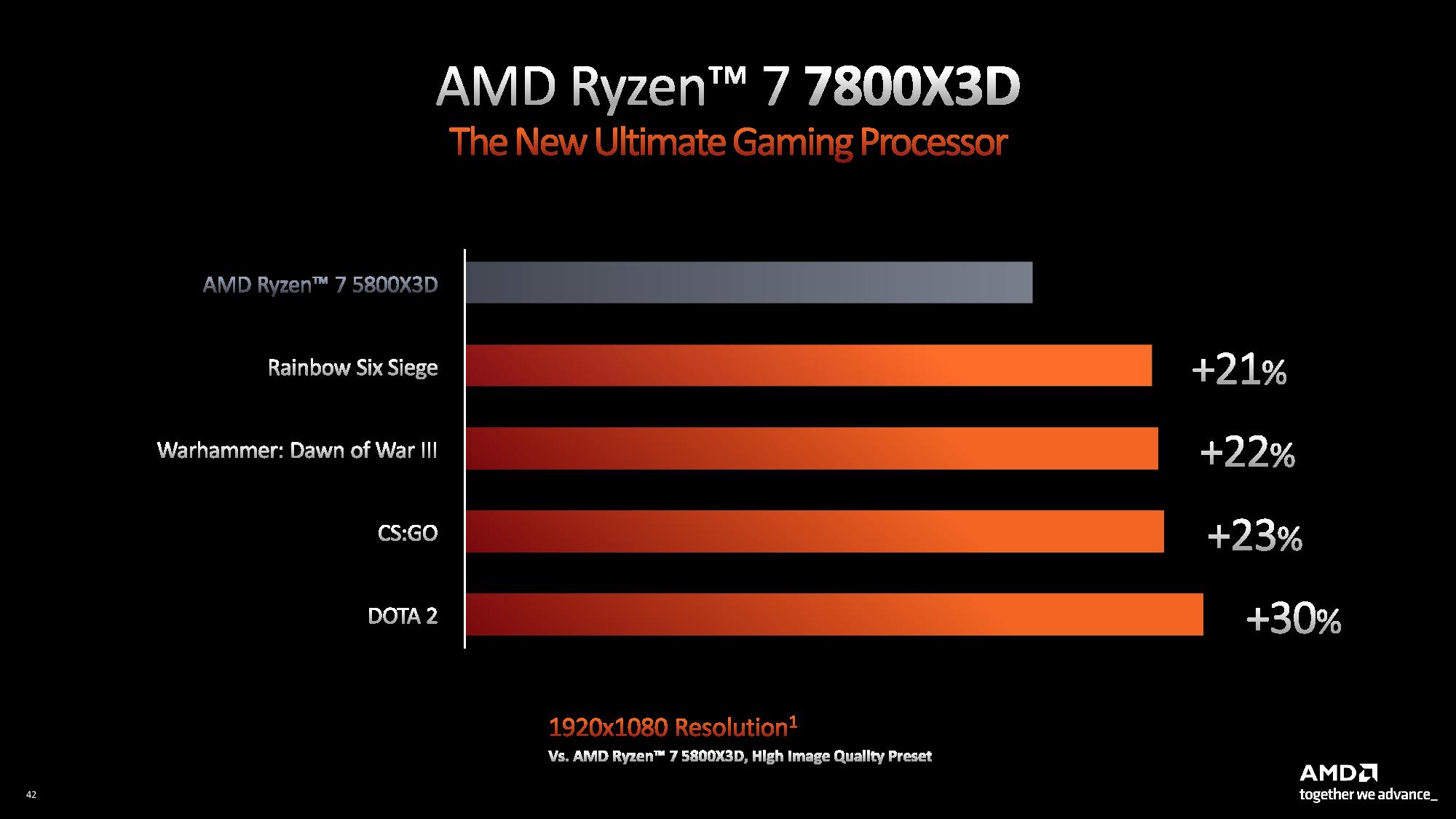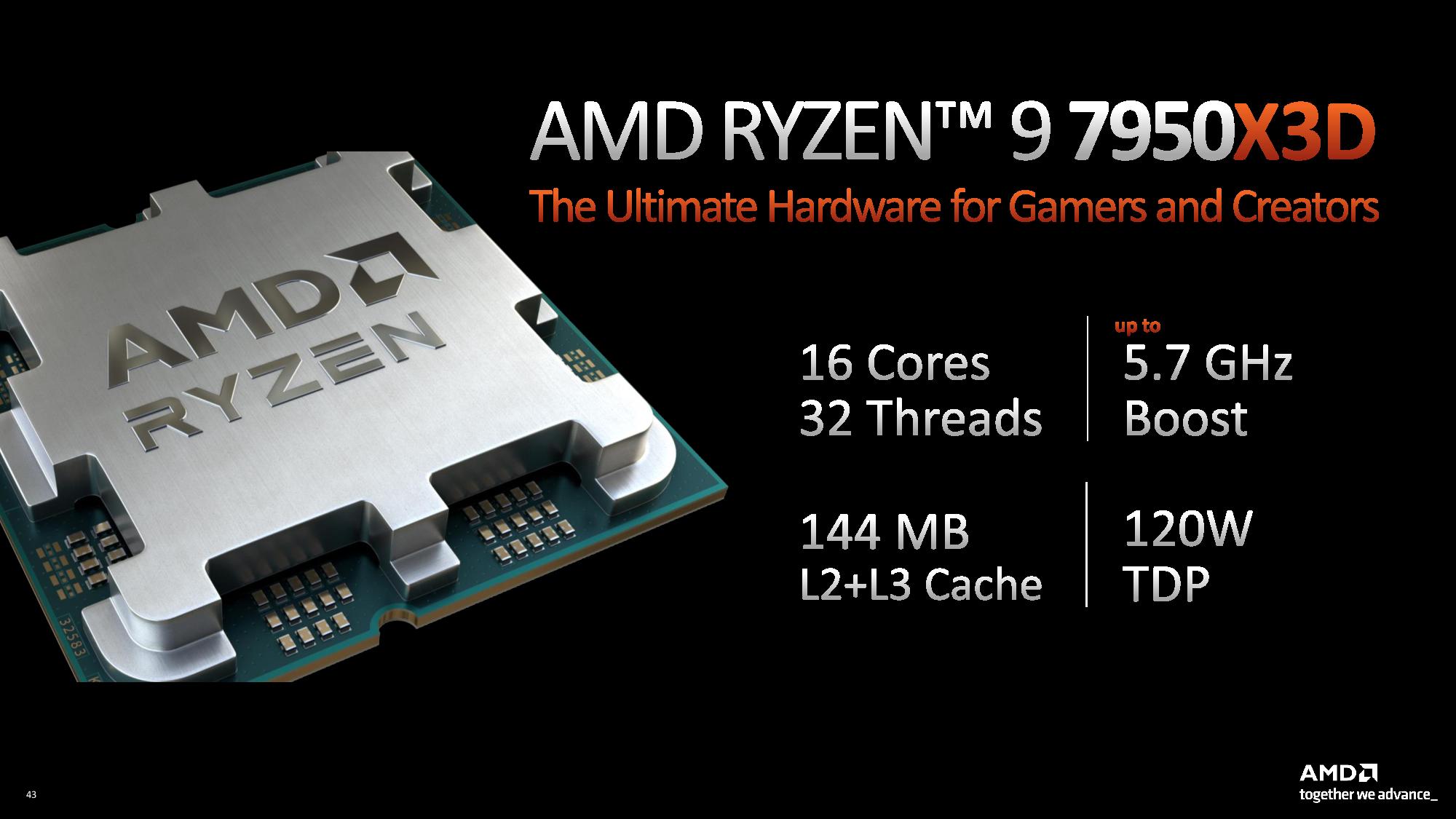AMD Announces Ryzen 7000X3D Pricing: $449 to $699 Starting Feb 28th
3D V-Cache to the masses.
AMD announced three new Zen 4 Ryzen 7000X3D processors for its AM5 platform at CES 2023, and today it shared the pricing and availability for the Ryzen 7000X3D processors in a surprise video it posted to its YouTube channel.
The first two chips will arrive on February 28: The 16-core 32-thread 7950X3D at $699 and the 12-core 24-thread Ryzen 9 7900X3D that weighs in at $599. The eight-core, 16-thread Ryzen 7 7800X3D arrives on April 6 for $449. This represents anywhere from a $100 to $180 premium over the street pricing for AMD's non-X3D versions of these chips.
| Price | Cores / Threads (P+E) | P-Core Base / Boost Clock (GHz) | Cache (L2/L3) | TDP / PBP / MTP | |
|---|---|---|---|---|---|
| Ryzen 9 7950X3D | $699 | 16 / 32 | 4.2 / 5.7 | 144MB (16+128) | 120W / 162W |
| Ryzen 9 7900X3D | $599 | 12 / 24 | 4.4 / 5.6 | 140MB (12+132) | 120W / 162W |
| Ryzen 7 7800X3D | $449 | 8 /16 | 4.2 / 5.0 | 104MB (8+96) | 120W / 162W |
| Ryzen 7 5800X3D | $358 | 8 /16 | 3.4 / 4.5 | 104MB (8+96) | 105W |
The three new high-end Ryzen 7000X3D processors come with the company’s revolutionary 3D V-Cache in chips that top out at an incredible 5.7 GHz, a much higher peak boost frequency than we saw with the first-gen models. This now-proven tech could allow AMD to snatch the top spot in our list of best CPUs for gaming and our CPU benchmark hierarchy from Intel’s potent Raptor Lake when they arrive in February.
The new high-performance AMD chips come in 8-, 12- and 16-core flavors, significantly expanding the lineup of 3D V-Cache chips over the eight-core Ryzen 7 5800X3D model that arrived as the lone first-gen X3D model. AMD claims explosive generational performance gains with these new chips, saying they will beat Intel’s fastest gaming chip by up to 24% in some games.
AMD Ryzen 9 7950X3D, Ryzen 7 7900X3D, Ryzen 7 7800X3D Gaming Benchmarks, Pricing and Specifications
| Street/MSRP | Cores / Threads (P+E) | P-Core Base / Boost Clock (GHz) | E-Core Base / Boost Clock (GHz) | Cache (L2/L3) | TDP / PBP / MTP | Memory | |
|---|---|---|---|---|---|---|---|
| Ryzen 9 7950X3D | $699 | 16 / 32 | 4.2 / 5.7 | 144MB (16+128) | 120W / 162W | DDR5-5200 | |
| Core i9-13900K / KF | $589 (K) - $564 (KF) | 24 / 32 (8+16) | 3.0 / 5.8 | 2.2 / 4.3 | 68MB (32+36) | 125W / 253W | DDR4-3200 / DDR5-5600 |
| Ryzen 9 7950X | $579 ($699) | 16 / 32 | 4.5 / 5.7 | - | 80MB (16+64) | 170W / 230W | DDR5-5200 |
| Ryzen 9 7900X3D | $599 | 12 / 24 | 4.4 / 5.6 | 140MB (12+132) | 120W / 162W | DDR5-5200 | |
| Ryzen 9 7900X | $419 ($549) | 12 / 24 | 4.7 / 5.6 | - | 76MB (12+64) | 170W / 230W | DDR5-5200 |
| Core i7-13700K / KF | $409 (K) - $384 (KF) | 16 / 24 (8+8) | 3.4 / 5.4 | 2.5 / 4.2 | 54MB (24+30) | 125W / 253W | DDR4-3200 / DDR5-5600 |
| Ryzen 7 7800X3D | $449 | 8 /16 | 4.2 / 5.0 | 104MB (8+96) | 120W / 162W | DDR5-5200 | |
| Ryzen 7 5800X3D | $323 ($449) | 8 /16 | 3.4 / 4.5 | 104MB (8+96) | 105W | DDR4-3200 | |
| Ryzen 7 7700X | $349 ($399) | 8 /16 | 4.5 / 5.4 | - | 40MB (8+32) | 105W / 142W | DDR5-5200 |
| Ryzen 5 7600X | $249 ($299) | 6 / 12 | 4.7 / 5.3 | - | 38MB (6+32) | 105W / 142W | DDR5-5200 |
| Core i5-13600K / KF | $319 (K) - $294 (KF) | 14 / 20 (6+8) | 3.5 / 5.1 | 2.6 / 3.9 | 44MB (20+24) | 125W / 181W | DDR4-3200 / DDR5-5600 |
As a reminder, AMD’s 3D V-Cache uses a vertically 3D-stacked SRAM chip that sits on top of the processor die, thus boosting the L3 cache capacity by 64MB and enabling explosive performance gains in gaming (productivity workloads don’t benefit). This tech debuted in AMD’s Ryzen 7 5800X3D, the first ‘X3D’ model that took the top of our gaming charts upon its release. Intel doesn’t have comparable technology, but it recently released the 6 GHz Core i9-13900KS to help hold off AMD's new models.






We'll get to the detailed specs below, but first, AMD shared some performance benchmarks at CES 2023. These charts have an unlabeled axis, so take them with salt. AMD showed performance results in four titles that are often CPU bound, so the benefits of the X3D architecture shine through, particularly at the 1080p resolution used for testing.
AMD claims the 16-core 7950X3D is anywhere from 13% to 24% faster than the Intel flagship Core i9-13900K in these titles.
The Ryzen 7 7800X3D also appears potent, with AMD’s benchmarks showing it anywhere from 21% to 30% faster than the previous-gen Ryzen 7 5800X3D in this selection of titles. The Ryzen 7 5800X3D is a wonderful gaming processor, but it suffers tremendously in application benchmarks. That tradeoff appears to be drastically reduced with the 7950X3D, as AMD claims that it is anywhere from 4% to 52% faster than the Core i9-13900K in a selection of productivity benchmarks.
The $699 Ryzen 9 7950X3D comes with 16 cores and 32 threads, marking a new high core count for the 3D V-Cache-equipped chips. The 7950X3D is basically a Ryzen 9 7950X with an extra L3 cache chiplet and additional tuning. The X3D variant arrives at the same MSRP as the launch price for the 'vanilla' 7950X, which has seen steep price cuts of late that bring it to around $579.
The 3D-stacked L3 chip is 64MB, so the 7950X3D comes with 144MB of total cache, and 128MB of that is gaming-boosting L3 cache. This chip will contend with Intel’s Core i9-13900K and the 6 GHz 13900KS model.
Get Tom's Hardware's best news and in-depth reviews, straight to your inbox.
AMD has spec’d the 3D V-Cache processors at a base TPD of 120W and a max 162W PPT, which is lower than the standard 170W/230W threshold for the 7950X. That isn’t entirely surprising, as the additional cache chiplet can result in slightly higher operating temperatures. AMD recommends a minimum of a 280mm AIO watercooler for all 7000X3D models.
Regardless, AMD has significantly increased the boost speeds with the new X3D models. As a result, the 7950X3D boosts to 5.7 GHz, a vast leap over the previous gen 5800X3D’s peak of 4.5 GHz and the same as the standard 7950X. We see a slight decline of 200 MHz compared to the 7950X, a necessary accommodation for the lower 120W TDP.
The 7950X3D’s higher clock rate implies that we won’t see as much of a tradeoff in productivity apps with the new Zen 4 models, reducing a notable weakness of the first-gen 5800X3D model. However, the new X3D models do have a 50W reduction in available power compared to the standard Ryzen 7000 models, which will have an impact on threaded workloads.
Frequencies are higher for all three new X3D chips. The $599 12-core 24-thread Ryzen 9 7900X3D peaks at 5.6 GHz, the same as the standard 7900X, while base clocks decline a relatively minor 300 MHz (it’s rare to see the base clock in actual use). This chip comes armed with 104MB of cache, with 96 MB carved out as L3. This chip also drops to the lower 120W TDP range, so it will also lose some performance in heavily-threaded applications.
The 7950X3D and the 7900X3D have two eight-core CCD chiplets, marking the first time that AMD has brought this tech to a multi-CCD processor. However, the SRAM chiplet is only placed on one of the CCDs.
The $449 Ryzen 7 7800X3D is a single-CCD chip and comparable to the first-gen Ryzen 7 5800X3D, but it comes with the much faster Zen 4 architecture. The 8-core 16-thread 7800X3D has 96MB of L3 cache, the same core count and cache capacity as its Zen 3 predecessor. The 7800X3D has a base clock of 4.2 and a 5.0 GHz boost, both of which are higher than the 5800X3D’s 3.4 GHz base and 4.5 GHz boost.
The 7800X3D also has a 120W TDP, 15W higher than the 5800X3D and the current-gen eight-core Ryzen 7 7700X. Those faster clocks and higher TDP paired with the more modern Zen 4 architecture will yield performance boosts over the 5800X3D.
This Ryzen 7 7800X3D will be the chip to beat, as it will offer the lion's share of the X3D's gaming uplift, but come with the lightest price tag of the three. Therefore, it's no surprise that AMD will release this chip last to maximize sales of the pricier models. This chip arrives on April 6.
AMD also has an accompanying blog post. As you'd imagine, third-party benchmarks will come soon. Stay tuned.

Paul Alcorn is the Editor-in-Chief for Tom's Hardware US. He also writes news and reviews on CPUs, storage, and enterprise hardware.
-
PlaneInTheSky My problem with these cache heavy X3D CPU is that benefits are extremely game specific.Reply
There are games that are helped tremendously by more cache because they have data intensive algorithms that are CPU bound.
But there are are also many games that don't benefit from this at all.
And since I have no idea if the games I currently play, or will even play in the near future, will benefit from this, it's just a gamble. -
emike09 Let's see some MSFS benchmarks when they're available! That's the only title I play that really seems to benefit from X3D cache.Reply -
logainofhades Here's to hoping Microcenter extends the free ram bundle to these chips too. If so, I might be trying to snag me a 7800x3d. Even the 5800x3d, is quite an improvement, over my 5800x, for what I play. I have been wanting to build a new rig, for quite some time.Reply -
tennis2 What a strange product line to try and price....Reply
The vcache only really benefits games. The 7800X3D is best poised to take advantage of it, much like the 5800X3D. The higher tier options won't win because of more cores, but only really the additional cache/frequency.
So you have this non-linear performance transition from gaming to productivity where AMD has to hope that there's a lot of high-tier productivity-focused consumers out there buying their own hardware and gaming after hours....pretty niche I bet.
This essentially makes the 7800X3D the cash-cow that has to pay for the majority of the product stack, so you know value will be terrible. -
PEnns $699? $599???Reply
For the sake of Pete, can't those bean counters at AMD learn one stupid lesson and do something smart for once?? Especially after the DDR 5 debacle.
How about reducing the price of those new CPUs by 20 % ,which most likely will result in higher sales volume - which will more than make up for the slightly lower price?????
They seem to have graduated from the "Let me shoot myself in the foot - REPEATEDLY" college!! -
gggplaya These will be the new kings of Star Citizen, which will release in the year 2159. Very cache heavy game.Reply -
tennis2 Reply
One thing is for sure. AMD is pretty high on their horse ever since the 5000 series launch. Best to wait 6 months for price to fall by >30% off launch seems to be the trend they're setting for themselves.PEnns said:$699? $599???
For the sake of Pete, can't those bean counters at AMD learn one stupid lesson and do something smart for once?? Especially after the DDR 5 debacle.
How about reducing the price of those new CPUs by 20 % ,which most likely will result in higher sales volume - which will more than make up for the slightly lower price?????
They seem to have graduated from the "Let me shoot myself in the foot - REPEATEDLY" college!! -
bill001g What matter now is what the actual street price end up. Even if the 7800x3d comes in at a similar price to the 13700k it is going to have to have much better numbers in gaming since the 13700k will likely massively beat it on any benchmark that can not take advantage of the new cache.Reply
The 7900x is already just barely faster than the 13700k and you wouldn't think they would allow the 7800x3d to outperform the 7900x for $100 less.
Then you have the issue of total costs for people that aren't willing to pay the extra for ddr5 memory and motherboards.
I am not real surprised I guess to really win they would need 13700k performance but still sell it for 5800x3d prices. Maybe it will they both have the same MSRP :) -
Kona45primo Prices are inline for performance. Should stomp Intel on the titles that benefit from the cache. Plus it'll allow for reasonable "sale" prices.Reply
AMD knows these prices will have to come down in the next few months to keep sales high. Start em high and drop em down. Early adopter tax just like every other high end bleeding edge piece of gaming hardware.
With people still paying out the nose for 4090's & XTX's, these will sell like hotcakes and hopefully bring another round of discounts to the 5800x3d.
With Intel planning on using TSMC for chip production this year it'll be interesting if they can use the 3d stacking cache as well... Would be nice to keep the competition across all the chip specializations. Close competition = fair prices & motivated R&D. -
-Fran- They're high for my taste, but at least should drive the prices of the X and non-X parts down even more.Reply
I'd tell people to just wait for them to go on sale or* have good bundles with other hardware components.
Regards.

